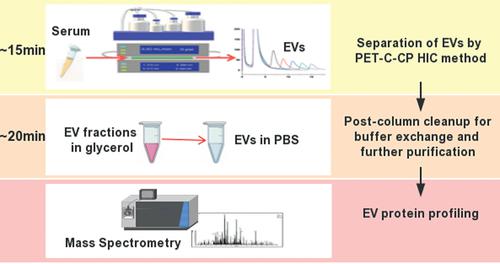当前位置:
X-MOL 学术
›
Electrophoresis
›
论文详情
Our official English website, www.x-mol.net, welcomes your feedback! (Note: you will need to create a separate account there.)
A novel method of high‐purity extracellular vesicle enrichment from microliter‐scale human serum for proteomic analysis
Electrophoresis ( IF 2.9 ) Pub Date : 2020-11-09 , DOI: 10.1002/elps.202000223 Xiaohui Ji 1, 2 , Sisi Huang 3 , Jie Zhang 1 , Terri F Bruce 4 , Zhijing Tan 1 , Donglin Wang 2 , Jianhui Zhu 1 , R Kenneth Marcus 3 , David M Lubman 1
Electrophoresis ( IF 2.9 ) Pub Date : 2020-11-09 , DOI: 10.1002/elps.202000223 Xiaohui Ji 1, 2 , Sisi Huang 3 , Jie Zhang 1 , Terri F Bruce 4 , Zhijing Tan 1 , Donglin Wang 2 , Jianhui Zhu 1 , R Kenneth Marcus 3 , David M Lubman 1
Affiliation

|
We have developed a rapid, low‐cost, and simple separation strategy to separate extracellular vesicles (EVs) from a small amount of serum (i.e.,<100 μL) with minimal contamination by serum proteins and lipoprotein particles to meet the high purity requirement for EV proteome analysis. EVs were separated by a novel polyester capillary channel polymer (PET C‐CP) fiber phase/hydrophobic interaction chromatography (HIC) method which is rapid and can process small size samples. The collected EV fractions were subjected to a post‐column cleanup protocol using a centrifugal filter to perform buffer exchange and eliminate potential coeluting non‐EV proteins while minimizing EV sample loss. Downstream characterization demonstrated that our current strategy can separate EVs with the anticipated exosome‐like particle size distribution and high yield (∼1 × 1011 EV particles per mL of serum) in approximately 15 min. Proteome profiling of the EVs reveals that a group of genuine EV components were identified that have significantly less high‐abundance blood proteins and lipoprotein particle contamination in comparison to traditional separation methods. The use of this methodology appears to address the major challenges facing EV separation for proteomics analysis. In addition, the EV post‐column cleanup protocol proposed in the current work has the potential to be combined with other separation methods, such as ultracentrifugation (UC), to further purify the separated EV samples.
中文翻译:

一种从微升级人血清中富集高纯度细胞外囊泡用于蛋白质组分析的新方法
我们开发了一种快速、低成本、简单的分离策略,从少量血清(即<100 μL)中分离出细胞外囊泡(EV),同时最大限度地减少血清蛋白和脂蛋白颗粒的污染,以满足细胞外囊泡的高纯度要求。 EV 蛋白质组分析。通过新型聚酯毛细管通道聚合物(PET C-CP)纤维相/疏水相互作用色谱(HIC)方法分离电动汽车,该方法快速且可以处理小尺寸样品。使用离心过滤器对收集的 EV 级分进行柱后净化方案,以进行缓冲液交换并消除潜在的共洗脱非 EV 蛋白,同时最大限度地减少 EV 样品损失。下游表征表明,我们当前的策略可以在大约 15 分钟内分离具有预期外泌体样粒径分布和高产量(每毫升血清约1 × 10 11 EV 颗粒)的 EV。EV 的蛋白质组分析表明,与传统分离方法相比,鉴定出一组真正的 EV 成分,其高丰度血液蛋白和脂蛋白颗粒污染显着减少。这种方法的使用似乎解决了蛋白质组学分析中 EV 分离面临的主要挑战。此外,当前工作中提出的EV柱后净化方案有可能与其他分离方法(例如超速离心(UC))相结合,以进一步纯化分离的EV样品。
更新日期:2020-11-09
中文翻译:

一种从微升级人血清中富集高纯度细胞外囊泡用于蛋白质组分析的新方法
我们开发了一种快速、低成本、简单的分离策略,从少量血清(即<100 μL)中分离出细胞外囊泡(EV),同时最大限度地减少血清蛋白和脂蛋白颗粒的污染,以满足细胞外囊泡的高纯度要求。 EV 蛋白质组分析。通过新型聚酯毛细管通道聚合物(PET C-CP)纤维相/疏水相互作用色谱(HIC)方法分离电动汽车,该方法快速且可以处理小尺寸样品。使用离心过滤器对收集的 EV 级分进行柱后净化方案,以进行缓冲液交换并消除潜在的共洗脱非 EV 蛋白,同时最大限度地减少 EV 样品损失。下游表征表明,我们当前的策略可以在大约 15 分钟内分离具有预期外泌体样粒径分布和高产量(每毫升血清约1 × 10 11 EV 颗粒)的 EV。EV 的蛋白质组分析表明,与传统分离方法相比,鉴定出一组真正的 EV 成分,其高丰度血液蛋白和脂蛋白颗粒污染显着减少。这种方法的使用似乎解决了蛋白质组学分析中 EV 分离面临的主要挑战。此外,当前工作中提出的EV柱后净化方案有可能与其他分离方法(例如超速离心(UC))相结合,以进一步纯化分离的EV样品。



























 京公网安备 11010802027423号
京公网安备 11010802027423号